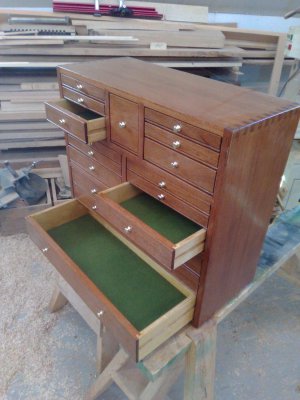We used to use a lot of Baltic birch plywood. It came from either Finland or Russia. I suspect the Russian stuff is no longer available. There is a domestic supplier of something similar. (Appleply?) All the thin plays make BB stronger as does the use of a hardwood. You should let the bottoms into a groove. 8mm Baltic birch is quite strong, 12mm is probably overkill. Using box joints for the sides/front back connections is strong and once setup on a table saw easy to make repetitive joints. Be sure to check square as you clamp the drawer boxes. With the drawer upside down put a bead of hot melt around the joint between the box & bottom. Hold the bottom down so the hot melt fills any void. Semi- decent Chinese ball bearing full extension, side mount drawer guides are available pretty cheap. Similar to what the metal roll-around tool cabinets use. Make a simple jig to mount them. Make a simple support jig to locate the case members while you screw them on. Accuracy is important to get a nicely working drawer. Leaving an additional 1/32" of case opening is easier than needing to shave down the drawer sides. If for some reason you end up with a bit too wide of opening just shim the guides out. I prefer hardwood drawer boxes to plywood because the groove for the drawer bottoms will be weak in plywood. Original Titebond wood glue for drawer joint assembly. Finish the drawers so they don't absorb grease & oil, just for esthetics. Never use the drawer front as the stop! A table saw is all that is needed. Do not use stapled joints! Pilot drilled for assembly screws as an easier out. Those screws have very aggressive, sharp threads with an auger tip and countersinking nibs under the head. Robertson (Sq. Drive) heads are best. Use an impact driver, NOT a drill. Ouch, a dissertation!
There are companies that specialize in making drawers if you don't feel like doing it. You can get them KD to save on shipping.



